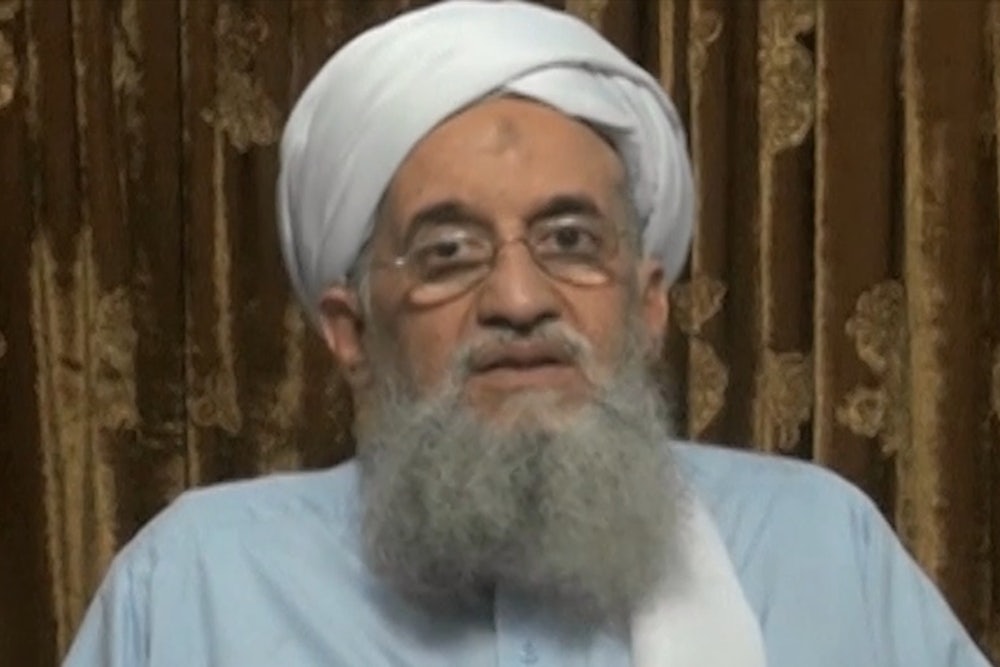When Ayman al-Zawahiri, the Al Qaeda leader, announced in a video Wednesday that the terrorist organization had formed a new affiliate in South Asia—Al Qaeda in the Indian Subcontinent, or AQIS—some observers described the group as India-centric or part of an attempt to stave off the emergent Islamic State (IS). But both the video’s content and Al Qaeda’s steady media outreach to South Asians over the past few years tell a much different story.
In the fifty-five minute video, available in both Arabic and Urdu, al-Zawahiri says the new group was two years in the making. In other words, the preparations for AQIS began a year after Osama bin Laden was killed; after Al Qaeda’s Arab operatives in Pakistan have largely been eliminated in U.S. drone strikes and Pakistani intelligence operations; amid the strengthening of Al Qaeda affiliates in North Africa and Yemen; and well before the spread of IS and establishment of its caliphate.
Al Qaeda wants to anchor its presence in all of South Asia, not just India, anticipating both a post-American Afghanistan and a post-Zawahiri Al Qaeda As America ends its combat operations in Afghanistan, a primary motivating force for jihad in the region weakens and may disappear. And if al-Zawahiri dies or is killed, the next central Al Qaeda leader could come from one of its affiliate groups based outside the Afghanistan-Pakistan region. AQIS provides a framework for Al Qaeda to remain active in South Asia, where it has been based for almost three decades, even if its central command moves elsewhere. And, just as important, AQIS comes along with a narrative to underpin a long-term jihad in South Asia.
That narrative is Ghazwa al-Hind or the Battle of India, referenced to in a hadith or Islamic prophetic tradition. This tradition, mentioned by al-Zawahiri in the video, foretells the Muslim conquest of all of historic India and states that those who participate in this battle will be awarded Paradise in the hereafter, just like those who will take part in the great End Times war in the Levant. The area of al-Hind encompasses the core portions of Pakistan not bordering Afghanistan, along with all of India, Bangladesh, and parts of Myanmar. Al-Zawahiri and the other two men in the video, Asim Umar, the AQIS amir or leader, and Osama Mahmood, the new group’s spokesman, state that their goal is to establish an Islamic state in this entire territory while also aiding the Afghan Taliban in retaking Afghanistan.
Within the global jihadist community, there’s consternation that al-Zawahiri has yet to issue a statement on IS’s establishment of a caliphate, which threatens Al Qaeda's position as vanguard of the global jihad. And there are a number of subtle, apparent inferences to IS in the video. For example, AQIS spokesman Mahmood suggests that his group will offer a kindler, gentler caliphate, so to speak, that will protect the oppressed from the oppressor, “even if the oppressed is a disbeliever.” This is likely an indirect reference to ISIS’s wanton killing of non-Muslims as well as Muslims.
But we should resist the urge to see the creation of AQIS as all about IS. For the past few years, Al Qaeda has stepped up its outreach to Pakistanis. Its Urdu-language service is among its most active. Al-Zawahiri has also made a handful of statements addressing the plight of Muslims in Burma and India, and Islamic activists targeted by the state in Bangladesh. It's been laying the groundwork for AQIS for some time.
Indeed, more than beating out competition from IS, Al Qaeda is trying to fill a void in the South Asian jihadist community—the absence of a grand patron. While Pakistan’s intelligence services continue to support militant groups in the region, such as Lashkar-e Taiba, its support for militants in Indian-controlled Kashmir has remained low for much of the past decade. That’s why Umar, the AQIS chief, in another video released this summer, asked Kashmiri Muslims to join Al Qaeda’s ranks and accused Pakistan of selling them out.
With the election of Hindu nationalist Narendra Modi as India’s prime minister, and the continued persecution of Muslim Rohingyas in Burma by the Buddhist majority, Al Qaeda aims at making inroads among aggrieved and persecuted Muslims. We can expect Al Qaeda to attempt to engage in attacks on India, to present itself as the defender of the region’s Muslims and push Islamabad and New Delhi to war. Despite their troubles at home, though, Indian Muslims have largely resisted the call of jihad.
That leaves Pakistan. AQIS has left its role there strategically ambiguous—and for good reason. The Pakistani Taliban umbrella group created in 2007 has split into a number of factions, creating a messy jihadist landscape in Pakistan. But Umar says in the video that “the caravan of jihad” will begin in Pakistan and will reach India, Bangladesh, and Burma. That’s probably why Al Qaeda has chosen Umar, a cleric—not a military commander—as its AQIS chief. He’s well known among Pakistan’s Deobandis, the Sunni subsect where most of South Asia’s jihadist groups come from. Through Umar and AQIS, Al Qaeda is entrenching in Pakistan and gearing up for a long war in South Asia that will continue well after the U.S. has left the region.
